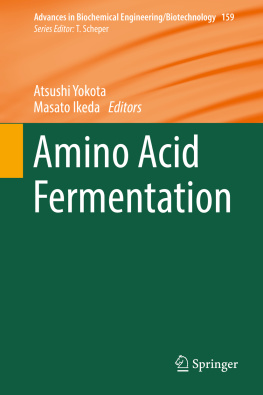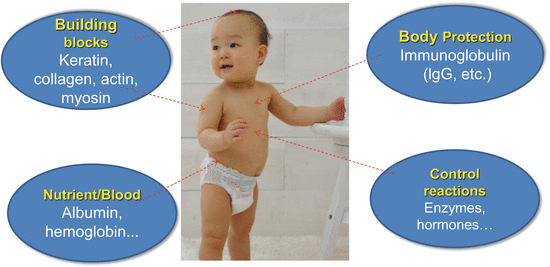Springer International Publishing Switzerland 2016
Atsushi Yokota and Masato Ikeda (eds.) Amino Acid Fermentation Advances in Biochemical Engineering/Biotechnology 10.1007/10_2016_23
Abstract
At present, amino acids are widely produced and utilized industrially. Initially, monosodium glutamate (MSG) was produced by extraction from a gluten hydrolysate. The amino acid industry started using the residual of the lysate. The discovery of the functions of amino acids has led to the expansion of their field of use. In addition to seasoning and other food use, amino acids are used in many fields such as animal nutrients, pharmaceuticals, and cosmetics. On the other hand, the invention of the glutamate fermentation process, followed by the development of fermentation methods for many other amino acids, is no less important. The supply of these amino acids at a low price is very essential for their industrial use. Most amino acids are now produced by fermentation. The consumption of many amino acids such as MSG or feed-use amino acids is still rapidly increasing.
Introduction
Amino acids are the building blocks of proteins. Each amino acid molecule has an amino group and a carboxyl group. At present, amino acids are widely produced and used in many fields. Table shows the production methods and industrial applications of each amino acid. There are many production methods such as extraction, chemical synthesis, fermentation, and enzymatic conversion. Fermentation is suitable for the large-scale production of optically active compounds. Most amino acids are now produced by fermentation, although some such as glycine or dl -methionine are still produced by chemical synthesis or enzymatic production. On the other hand, the field of amino acids is not limited to seasoning. In the livestock industry, pharmaceuticals, and cosmetics, various amino acids are also used in large amounts. In this chapter, we review the present situation of the amino acid industry in some fields along with their functions.
Table 1
Production methods and industrial applications of amino acids
Amino acid | Production method | Industrial application |
|---|
Fermentation | Enzymatic conversion | Chemical synthesis | Extraction | Pharmaceuticals | Food | Cosmetics | Animal feed | Other industrial uses |
|---|
l -Alanine |
dl -Alanine |
l -Arginine |
l -Asparagine |
l -Aspartate |
l -Citrulline |
l -Cysteine |
l -Glutamate (monosodium) |
l -Glutamine |
Glycine |
l -Histidine |
l -Isoleucine |
l -Leucine |
l -Lysine (chloride) |
l -Methionine |
dl -Methionine |
l -Ornithine |
l -Phenylalanine |
l -Proline |
l -Serine |
l -Threonine |
l -Tryptophan |
l -Tyrosine |
l -Valine |
Amino Acids and Fermentation
Amino acids are the building blocks of proteins. The amino group of an amino acid molecule can connect to the carboxyl group of another amino acid. The chained amino acids are called proteins. Our bodies contain hundreds of thousands of proteins (Fig. ]. In the nutrition field, 20 amino acids are divided into two categories: essential (indispensable) amino acids and nonessential (dispensable) amino acids. Essential amino acids are not produced by our body and must be obtained through food. It is often assumed that only essential amino acids are important, whereas nonessential amino acids are not so important. However, this assumption has recently been proven to be untrue. From the physiological point of view, obtaining amino acids from food saves energy. Nonessential amino acids have many biological functions, not only as building blocks but also as intermediates in the metabolic system of the body (energy sources, nitrogen donors, and precursors of other compounds); therefore, we should be aware of the mechanism for synthesizing these amino acids.
Fig. 1
Proteins in human body
Fermentation is a conversion process by microorganisms. There are many fermented foods worldwide, such as miso (bean paste) and soy sauce made from soybeans, paste and sauce made from fish or shrimp, nata (gelatinous pellicle) from coconut juice (nata de coco), yogurt and cheese from milk, sauerkraut (sour cabbage), and many kinds of pickles and alcohols made from local materials. Another type of fermentation is the conversion of sugars into useful compounds. Such fermentation results in the efficient production of the desired substances. It is effective in the production of optically active substances. Low-price carbohydrates such as starch, crude sugar, and molasses are used as the raw material.
Outline of the History of the Amino Acid Industry
In 1908, Prof. Kikunae Ikeda discovered glutamate as the umami substance. Following this, monosodium glutamate (MSG) was sold as seasoning in 1909. MSG was the first industrially commercialized amino acid. At that time, glutamate was extracted from the hydrolysate of wheat protein. In wheat, glutamic acid constitutes 30% of the total amino acids. Therefore, 70% is other amino acids. The applications of the remaining amino acids marked the start point of the amino acid industry. We started with a modest beginning from glutamic acid to more efficient use of that acid and expanded into other amino acids as well.
In 1935, the production of the first pharmaceutical product made with amino acids, Histamine B, was started. Following this, in the 1950s, a highly purified pharmaceutical-use amino acid product for infusions was launched. In the 1960s, feed-use amino acid production was started using the fermentation method. The fermentation process made it possible to produce large amounts of amino acids at a low cost. One of the important properties of these molecules is their reactivity. Amino acids express novel functions by reacting with other substances. For example, amino acid such as glutamate can react with fatty acids. The product, N-acyl glutamate, has a mild detergent activity and is used in the cosmetics field as a nonirritating soap. In recent years, many fundamental food and biotechnology businesses are being developed on the basis of the newly discovered physiological functions of amino acids.
Umami, Glutamate, and MSG
Umami is one of the five basic tastes (Table ]. When umami substance binds to the taste buds, we perceive the taste. How do we perceive the taste? A signal is generated and transferred to the brain through the taste nerve. For tastes other than the basic ones such as hot, spicy, or astringent, the signal is different. It is transferred to the brain through another nerve system (the trigeminal nerve).










